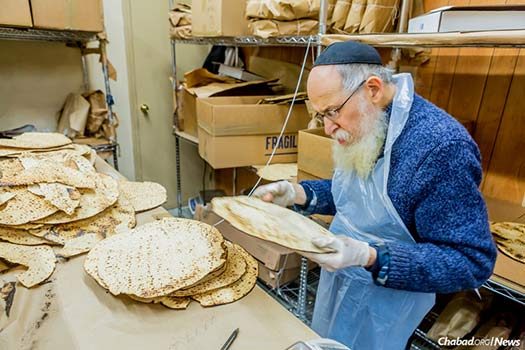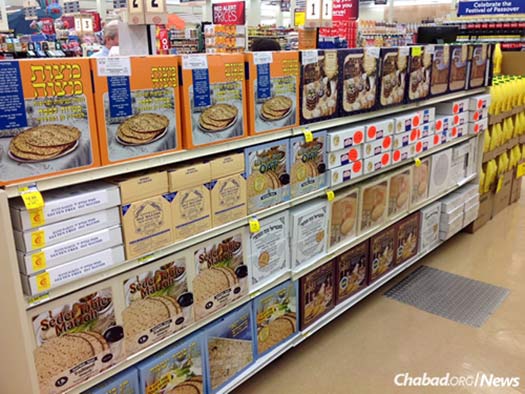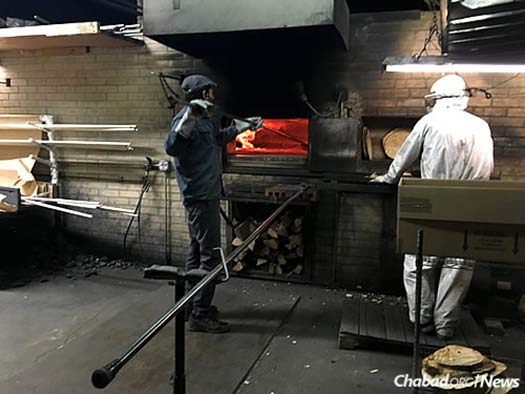
1 Million Pounds of Shmurah Matzah: How Passover Production Continues to Rise
by Dovid Margolin – Chabad.org
Passover is around the corner, and handmade shmurah matzah is starting to pop up on supermarket shelves. Before long, it’ll be everywhere—from Costco to the White House. Demand for the traditional, round matzah has grown at a rapid rate in the last 60 years, and according to a survey conducted by Chabad.org, more than 1 million pounds of the handmade variety will be produced in the United States alone. To meet the growing demand, matzah bakeries around the world begin baking shmurah matzah as early as October, producing batches of the tasty, smoking discs.
It wasn’t always like that. Tzal Rotter, 81, who grew up in Brooklyn’s Brownsville neighborhood, recalls being among only a handful of Jewish children eating shmurah matzah. On the eve of Passover, Rotter’s father would close up his kosher butcher shop and the two of them would make the long trip to Manhattan’s Lower East Side to purchase the special matzah.
“I remember it being the only matzah bakery around,” says Rotter. “It was in a tiny house with a storefront, and the bakery was downstairs in the basement.”
In 1954, the Rebbe—Rabbi Menachem M. Schneerson, of righteous memory—began talking about the importance of eating authentic shmurah matzah, encouraging his followers to distribute it to every Jew they met and to teach them about its significance. It was around that same time that he encouraged a recent Russian immigrant, Rabbi Yehoshua Korf, to open what became the Lubavitcher Matzah Bakery at 109 Broome St. on Manhattan’s Lower East Side.
The Rebbe’s insistence that shmurah matzah be made available around the country went beyond words. In one notable example, he arranged that the Chabad-Lubavitch movement’s central educational organization, Merkos L’Inyonei Chinuch, pay for Korf’s shmurah matzah advertisements in Chicago through the Chabad emissary there at the time, Rabbi Shlomo Zalman Hecht.
On the other side of the country, Chabad’s first representative in Los Angeles, Rabbi Shmuel Dovid Raichik, heeded the Rebbe’s call and became the sole distributor of handmade shmurah matzah on the West Coast. Despite the lack of demand within the Jewish community, each year before Passover, Raichik and his sons would go to UPS to pick up the boxes of round matzah sent to him by Korf.
One of Raichik’s primary focuses was delivering the matzah to Jewish day schools throughout Southern California. In this way, he ensured that generations of children would learn about the special matzah in school before taking it home and insisting that their parents eat it at the seder.
“My father would walk into principals’ offices and sell them on the idea,” recalls the late rabbi’s son Rabbi Shimon Raichik. “Then the kids had it at their seder.”
‘They Developed the Demand’
“What’s interesting about the emergence of shmurah matzah in American Jewish life is that for most, their immediate ancestors didn’t use it,” notes Jeffrey Gurock, professor of Jewish history at Yeshiva University and author of Jews in Gotham: New York Jews in a Changing City, and more recently, Jews of Harlem. “The Rebbe’s matzah campaign is very important in introducing it, and its authenticity resonated even among Jews who are not particularly observant.”
Yossi Frimerman has been a wholesaler of shmurah matzah since 1976, and is the man largely responsible for getting handmade matzah into the supermarket aisle. Demand had picked up by the time he got into the business, yet the price of American shmurah matzah was still too high for supermarkets.
Starting with the Pathmark chain in the New York area, Frimerman began stocking shelves in the New York area with lower-priced shmurah matzah imported from Israel, an effort that grew as he penetrated more markets further away from the tri-state area. Some markets expanded their offerings faster than others—something Frimerman unhesitatingly chalks up to the location of Chabad emissaries.
“The entire shmurah matzah market was able to develop first and foremost due to the shluchim,” attests Frimerman. “There was a time when they were the only ones distributing it, often for free and at a loss. They developed the demand.”
While adults received shmurah matzah from their local Chabad rabbis, their children were often learning about it through one of Chabad’s most popular yearly programs: the “Model Matzah Bakery” workshops. In the last few decades, hundreds of thousands of children have gotten the chance to make their own handmade matzah through this program conducted by Chabad at Chabad centers, Jewish community centers and other places around the world; in Toronto alone, some 3,000 children experience the program annually. While the matzah they make is for educational purposes and not kosher for Passover, each child also walks out with a small box of shmurah matzah.
Through seeing Chabad-supplied shmurah matzah at their family seders—soon after making their own from scratch—a generation of Jewish children has grown up with shmurah matzah, causing the demand to grow exponentially.
When President Barack Obama hosted the White House’s first-ever seder in 2009, the round, handmade matzah was supplied by a young aide from Springfield, Mass., named Eric Lesser. Eric’s father, Dr. Martin Lesser, had been receiving the round matzah from Chabad of Springfield’s Rabbi Dovid Edelman for decades, and when it came time to making the White House seder, it was only natural for Eric to bring the real stuff.
As the production and consumption of shmurah matzah continues to grow each year, Gurock, a keen observer of American Jewish life, synopsizes the product’s dramatic half-century of growth:“The Rebbe’s dictum ends up at the White House. That’s amazing!”
















very interesting
thank you!
Shirley Kayne
Very interesting to learn the whole story of shmura
matzoh ….enlightening information